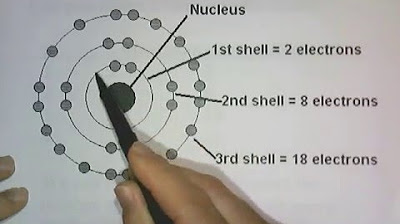Theory of Everything: What is Matter?
Summary
TLDRThe script explores the concept of matter through the lens of the Pauli Exclusion Principle, which states that electrons, being identical, cannot occupy the same quantum state. This principle is fundamental to understanding why matter cannot be compressed infinitely, as it prevents the same type of particle from existing in the same space, shaping the universe's structure and behavior.
Takeaways
- 🌌 Matter is omnipresent; we consume and interact with it daily.
- ❓ The fundamental definition of matter is rooted in the Pauli exclusion principle.
- ⚛️ Electrons are perfectly identical and cannot be distinguished from one another.
- 🔢 The concept of 'three-ness' illustrates the universality of numbers, similar to the 'electron-ness' of electrons.
- 🕊️ Every electron in existence is derived from a pervasive quantum field.
- 🎶 The idea that we share electrons with historical figures is akin to using the same number in arithmetic.
- ⚡ Anti-electrons can be summoned from the electron field and annihilate electrons upon contact.
- 🚫 Electrons cannot occupy the same quantum state, highlighting their aversion to similarity.
- 🏙️ The Pauli exclusion principle restricts the density of matter in a given space, preventing overcrowding.
- 🌍 At its core, matter encompasses any field from which particles and anti-particles can be summoned.
Q & A
What is the Pauli Exclusion Principle?
-The Pauli Exclusion Principle states that no two electrons can occupy the same quantum state simultaneously, meaning they cannot have identical quantum numbers in an atom.
Why do electrons hate being alike?
-Electrons hate being alike due to the Pauli Exclusion Principle, which prevents two or more electrons from occupying the same quantum state, ensuring that they are always distinct in their behavior and interactions.
What is meant by 'quantum field' in the context of electrons?
-A quantum field is a fundamental concept in quantum mechanics where particles like electrons are viewed as excitations of these fields. It's an everywhere-permeating field from which every electron in existence has been 'summoned'.
How are electrons perfectly identical?
-Electrons are perfectly identical because they are all manifestations of the electron quantum field, possessing the same properties and characteristics.
What is the relationship between electrons and anti-electrons?
-Electrons and anti-electrons (positrons) are antiparticles of each other. They have the same mass but opposite electric charge. When they meet, they annihilate each other.
Why can't you cram too much matter into the same place according to the script?
-You can't cram too much matter into the same place because of the Pauli Exclusion Principle, which prevents more than one electron from occupying the same quantum state in a given volume.
How does the Pauli Exclusion Principle affect the structure of matter?
-The Pauli Exclusion Principle affects the structure of matter by preventing the formation of tightly packed structures like skyscrapers, leading instead to compounds that spread outwards.
What is the practical implication of the Pauli Exclusion Principle for the universe?
-The practical implication of the Pauli Exclusion Principle for the universe is that it sets a limit on how much matter can be compressed into a given space, influencing the formation and behavior of celestial bodies and matter in general.
How does the Pauli Exclusion Principle relate to the concept of 'electron-ness'?
-The concept of 'electron-ness' refers to the idea that all electrons are identical manifestations of the electron quantum field. The Pauli Exclusion Principle ensures that despite their identical nature, they cannot occupy the same quantum state.
What is the significance of the statement 'every time you breathe, you inhale a few of the same electrons that used to be in Jesus or Mozart'?
-This statement emphasizes the idea that electrons are conserved and recycled throughout the universe. It's a poetic way of saying that electrons don't change their identity over time, just as the number 'three' remains the same regardless of who uses it.
How does the concept of 'anti-electron' relate to the Pauli Exclusion Principle?
-The concept of 'anti-electron' or positron is related to the Pauli Exclusion Principle in that it also cannot occupy the same quantum state as an electron. When a positron and an electron meet, they annihilate each other due to their opposite properties.
Outlines

Этот раздел доступен только подписчикам платных тарифов. Пожалуйста, перейдите на платный тариф для доступа.
Перейти на платный тарифMindmap

Этот раздел доступен только подписчикам платных тарифов. Пожалуйста, перейдите на платный тариф для доступа.
Перейти на платный тарифKeywords

Этот раздел доступен только подписчикам платных тарифов. Пожалуйста, перейдите на платный тариф для доступа.
Перейти на платный тарифHighlights

Этот раздел доступен только подписчикам платных тарифов. Пожалуйста, перейдите на платный тариф для доступа.
Перейти на платный тарифTranscripts

Этот раздел доступен только подписчикам платных тарифов. Пожалуйста, перейдите на платный тариф для доступа.
Перейти на платный тарифПосмотреть больше похожих видео

How Electron Spin Makes Matter Possible

Pauli exclusion principle: How spin works inside proton

Pauli Principle, Hund's Rule, Octet Rule & Aufbau Principle

An Electron's Quantum Address: Quantum Numbers

Quantum numbers - Remember easily

Energy Levels, Energy Sublevels, Orbitals, & Pauli Exclusion Principle
5.0 / 5 (0 votes)
